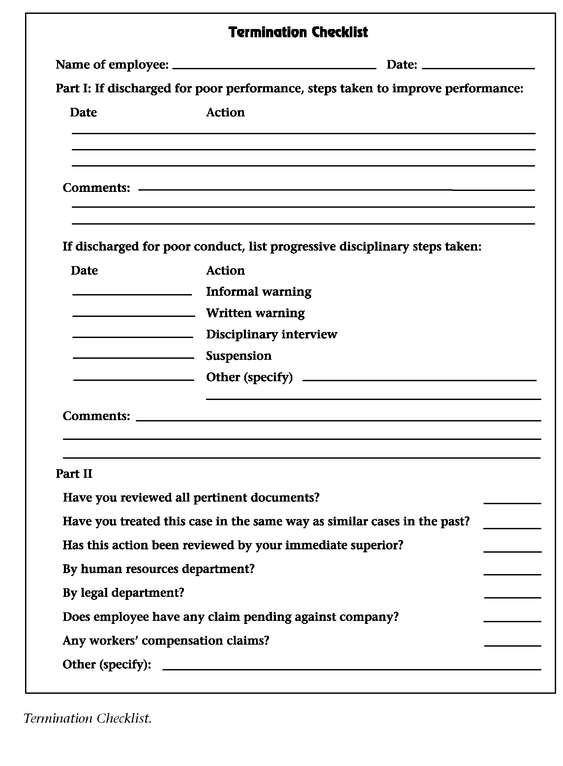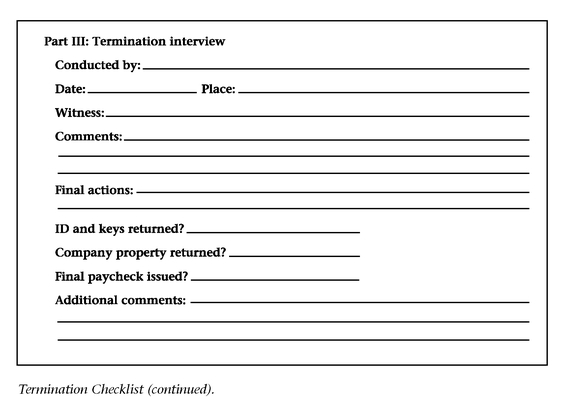
Chapter 25
How to Fire an Employee Legally and Tactfully
In This Chapter
➤ Employment at will—what it really means
➤ Preventing legal complications
➤ Termination when the employee can’t cut the mustard
➤ Firing after progressive discipline
➤ Firing disruptive employees
It’s never pleasant to fire an employee. Even if you’re glad to get rid of him or her, firing is a disagreeable task that most people do reluctantly. Yet sometimes your only course of action is to terminate an employee. As noted in the preceding chapter, a series of disciplinary steps usually leads to this final act. However, circumstances occasionally warrant an unplanned discharge.
Terminating employees is a serious matter that needs careful consideration. In most companies, before a supervisor or team leader can terminate anyone, approval must be obtained from both the manager to whom the supervisor reports and the human resources department. This step is necessary to ensure that company policies and legal requirements are fully observed. This chapter examines the importance of this process.
Employment at Will
“I’m the boss. I can fire anyone I think deserves it.” Right or wrong? Most modern managers will answer “wrong.” But they are only partly correct. True, there are a few legal restrictions on firing. However, because of employment at will, most managers can fire any employee for any reason or no reason at all. The only exceptions are those reasons specifically banned by law.

Meanings and Gleanings
Employment at will is a legal concept under which an employee is hired and can be fired at the will of the employer. The employer has the right, unless restricted by law or contract, to refuse to hire an applicant or to terminate an employee for any reason or for no reason.
Understanding the Law
Unless there is an employment contract with an employee or the employee is covered by a union contract, the employee is considered an employee at will. This concept has governed employment since colonial times. Bosses always had the right to fire employees—and it works both ways. Ever since slavery was abolished, employees have had the right to quit; only recently have these concepts been challenged.
To understand employment at will, you first have to know a little about our legal system. Americans are subject to two kinds of law: statutory law and common law. Statutes are the laws passed by Congress, the states, and local governments. Common law is based on accepted practices as interpreted by court decisions over the years.
The primary difference between the two types of law is that common law can be superseded or modified by legislation and can be changed in individual cases by mutual agreement between the involved parties. A violation of common law is not a criminal offense and is handled in a lawsuit as a civil action. Legislated statutes can be changed only by amendment, repeal, or court interpretation.
Employment at will is a common-law principle. Over the years various statutes have modified it. For example, there are laws that prohibit a company from firing or refusing to hire someone for union activity, race, religion, national origin, gender, disability, and age. The right under common law to hire or fire at will is therefore restricted in these circumstances.
This principle also means that employment at will can be waived by mutual consent. Employees can sign a contract with a company in which they agree not to quit and the firm agrees not to fire the employee for the duration of the contract. Or, the company and a union can agree that no union member will be fired except under the terms of the contract. In both cases, the company has given up its right to employment at will.
Employment Rights When No Contract Exists
During the past several years, a number of court cases have extended employees’ rights not covered by specific legislation. Courts in several states have ruled that although a company’s policies and procedures manual isn’t a formal contract, it can be considered to have the same effect as a contract.
In one case, a New York publishing firm fired a supervisor without going through the progressive discipline process. He sued on grounds that the policy manual called for progressive discipline before terminating an employee. He pointed out that when he had to discharge one of his staff members, he was required to follow the manual. However, when he was fired the company didn’t follow the procedure. The company’s contention was that the manual was intended only as a guide and not as a rigid procedure. The court ruled in favor of the employee. It ruled that if a policy is published in a manual, employees could expect that it will always be followed.
To avoid this type of problem, attorneys advise their clients to specify clearly in their company policy manuals that they are “at will” employers. This statement also should be included on employment application forms. A typical statement on this is shown in Chapter 7, “Screening Candidates.”

Personnel Perils
Although an employee can waive a common-law right by contract, he or she cannot waive a legislated right. For example, an employee cannot agree to work for less than the minimum wage.
Oral Commitments
Quite often when interviewing prospective applicants, the interviewer might make statements or promises that obligate the company. For example, during an interview, Stella was told that her job would be permanent after a six-month probationary period. A year later, the company downsized and Stella was laid off. She sued. She said, “I left my former job to take this one because the manager assured me that it was a permanent job.” The manager’s response: “I made that comment in good faith. Our company had never had a layoff, but circumstances changed.” That’s not good enough. The court ruled in Stella’s favor and awarded her a large settlement.
Preventive Maintenance
As this is a very sensitive area, managers should be extremely careful when discussing the nature of a job whether it be to an applicant or to a current employee. What you say—often in good faith—may backfire if circumstances change. To avoid these types of complications, follow these guidelines:
➤ All managers and team leaders should be trained in termination procedures and adhere to them.
➤ Management should never make commitments concerning tenure or other employment conditions orally or in writing. 

Tactical Tips
The following clause or one similar to it should be printed on all applications for employment and in employee handbooks: “This company follows an employment at will policy and employment may be terminated for any reason consistent with applicable federal and state laws. This policy cannot be changed verbally or in writing unless authorized specifically by the chairman or president of this company.”
➤ Make written job offers only after consulting with legal specialists.
➤ Never use the term “permanent employee.” NO ONE is a permanent employee. If your company must differentiate between full-time staff and temporary or part-time staff members, refer to the full-time people as “regular employees.”
➤ On all documents and records relating to employment conditions, state that the company has a policy of employment at will.
Following these guidelines will keep you out of trouble when it’s necessary to fire an employee.
Termination for Cause
There are two basic causes for terminating an employee. One is for inability to perform the job—poor performance; the other is for poor conduct—violation of company rules. Although the final steps of the termination process are much the same in both cases, what leads up to those steps differs.
Inability to Perform the Job
A set of performance standards should be established for every job. These often are included in the job description. These standards should be clearly explained to all people performing the job.
A major responsibility of a supervisor or team leader is to work with each person to ensure that the standards are met. If work is substandard, coaching, added training, and special attention should be provided. If at any time an employee’s work falls below the set standards, it’s incumbent upon the supervisor to do all that is possible to help correct the problem.
Some employees just don’t have the talent necessary to perform the job. In these cases, after a reasonable effort to help, it’s best to remove him or her from the job. If possible, transfer the employee to a more suitable position. If not, the only recourse is termination.
Before firing anybody for poor performance, every effort should be made to bring the performance up to standard. In some companies, employees who were fired for this reason sued on the grounds that they were not notified that their performance was below standard and management made no effort to help them. To protect against such charges, give the employee every chance to improve, document what you do, and use the sample memo form for poor performance from Chapter 23, “Doling Out Discipline.”
Termination for Poor Conduct
Employees who have gone through the steps of progressive discipline (see Chapter 23) should never be surprised when they get fired. Presumably, at every step along the way they were told what the next step would be. When an employee is suspended—the next-to-last stage in the disciplinary process—it must be made clear that if he or she doesn’t improve in the problem areas, the next step will be termination.
Preparing for Firing
Firing employees is a sensitive situation. You must do it diplomatically and be fully aware of the legal implications. Ask your human resources department for advice about dealing with this situation.
Some managers get more upset about having to fire someone than about losing the person who is being fired. Here are some suggestions to help you prepare:
➤ Review all documents so that you’re fully aware of all the reasons and implications involved in the decision to terminate the employee.
➤ Review all that you know about the employee’s personality:
➤ What problems have you had with the person?
➤ How did he or she respond to the preceding disciplinary steps?
➤ How did you and the employee get along on the job?
➤ How did he or she relate to other team members?
➤ What personal problems does the person have that you’re aware of?
➤ Review any problems you’ve had in firing other employees, and map out a plan to avoid those problems.
➤ Check your company’s policy manual or discuss with the human resources department any company rules that apply.
Make sure you relax before the meeting. Do whatever helps you clear your mind and calm your emotions. If you’ve done your job correctly, you’ve made every effort to help him or her succeed. The progressive discipline system has given the person several chances to change, so you don’t have to feel guilty about the firing.
You’re Fired!
You’ve stalled as long as you can. Now you’re ready to sit down with the employee and make clear that this is the end of the line. Find a private place to conduct the meeting. Your office is an obvious spot, but it might not be the best one. A conference room is better because, if the fired employees breaks down or becomes belligerent, you can walk out.
Most people who are fired expect it and don’t cause problems. They might beg for another chance, but this isn’t the time to change your mind. Progressive discipline gives people several “other chances” before they reach this point. Don’t let the termination meeting degenerate into a confrontation.
If the employee gives you a hard time, keep cool. Don’t lose your temper or get into an argument. It’s a good idea to have another person in the room at a termination meeting. A person being fired might say or do inappropriate things. Also, you might become upset and be tempted to say something that’s best left unsaid. The presence of a third person keeps both you and the employee from losing your temper and from saying or doing something that can lead to additional complications.
The best “third person” in a termination meeting is a member of the human resources department. If such a person isn’t available, call in another manager or team leader. If the employee belongs to a union, the union contract usually stipulates the presence of a union delegate.
Having a third person in the room when you terminate an employee also provides a witness if an employee later sues your company. Suppose a former employee files an age discrimination suit several weeks or months after being fired for poor performance. He or she claims that during the termination meeting, you stated that the company needs younger people to meet production standards.

Management Miscellany
Most companies fire people at the end of the workday on Friday afternoon. Psychologists say it’s better to terminate employees in the middle of the week, so they have a chance to begin looking for a new job the next day and won’t brood about the firing over the weekend.
Although the claim is false, you’ll have to spend time, energy, and money to defend your company against it—and it’s your word against the other person’s. If a third person is present at the termination meeting, former employees will be less likely to file false claims—they know they’ll be refuted by a witness.
In most organizations when a termination meeting ends, the employee should be escorted to the human resources department to handle the administrative procedures needed to complete the separation. When there is no human resources department at the facility, the supervisor usually has to take care of this. Make sure to follow the company’s procedures carefully. Use the following termination checklist to ensure that you take the necessary steps when terminating an employee.


Spontaneous Termination
Are there times when you’re so annoyed with an employee that you wish you could be the old-school boss and just say, “You’re fired”? Of course. That’s why progressive discipline was instituted—so that supervisors don’t let the emotions of the moment dictate their actions. Progressive discipline protects the employee from being fired by ruthless bosses and protects the company from the litigation that could result from such actions. However, under certain circumstances progressive discipline can be waived.
When You Can Do It
There are times when termination without warning is permitted. These occasions are rare and usually limited to a few serious infractions that are clearly delineated in company policies. Serious offenses include drinking on the job, fighting, stealing, and insubordination.
Because these charges aren’t always easy to prove, be very careful before you make the decision to fire someone without progressive discipline. You must have solid evidence that can stand up in court. Law books are loaded with cases in which people, because of a rash firing decision, have sued former employers for unlawful discharge, defamation of character, false imprisonment, and whatever else their lawyers can dream up.
Insubordination, which is one of the most frequent causes of spontaneous termination, isn’t always easy to prove. If an employee simply fails to carry out an order, it’s not enough grounds for termination. Unless a failure to obey instructions can lead to serious consequences, such as engaging in actions that endanger other workers, it’s better to use progressive discipline. On the other hand, if a team member becomes unruly in his or her refusal (if he or she hollers and screams or spits in your face, for example), spontaneous discharge might be appropriate.
Documenting a Spontaneous Discharge
When you fire someone after progressive discipline procedures fail, you have an entire series of documents to back you up. In spontaneous termination you have no such documents. Immediately after the termination, write a detailed report describing the circumstances that led up to it. Get written statements from witnesses. If you can, get the employee to sign a statement presenting his or her side of the story. If the discharge is later challenged and the terminated employee presents a different version of what happened, having his or her immediate comments will protect you.
You Can’t Fire Me—I Quit!
You’ve worked hard to bring Mike’s performance up to par. Despite your efforts he just can’t do the job. You tell him that you have to let him go. You explain that if he quits voluntarily, it will look better when he applies for another job. This option might sound sensible, but what happens if Mike applies for unemployment insurance and is told that he’s not eligible because he quit? If you give someone the option of resigning, be sure to inform the person about loss of unemployment insurance and any other negative factors.
Now suppose you try to be shrewd in getting rid of the person: “If I fire him,” you figure, “he’ll give me problems; so I’ll just make his life so miserable, he’ll quit.” Over the next few weeks you give him as many unpleasant assignments as you can. You time his returns from breaks and even how long he spends in the restroom. You chastise him for every minor violation of company rules and, after a few weeks, he quits.

Meanings and Gleanings
Rather than fire employees, some managers make life miserable for them so that they quit. When an employee quits because of intentional unfair treatment, it is “constructed” by the courts as equivalent to being fired and is referred to as constructive discharge.
Don’t be shocked when the person sues your company for unlawful discharge! When you tell the court, “I didn’t fire him, he quit,” the judge will respond “Not so. This is a constructive discharge—your treatment forced him to quit.” You might be ordered to pay the person back wages, rehire him, or make a satisfactory financial settlement.
The Least You Need to Know
➤ Other than for reasons prohibited by law or waived by contract, an employer can fire any employee for any reason or for no reason (employment at will).
➤ Prepare for a termination meeting by studying all the pertinent documents, reviewing the employee’s personal characteristics, and psyching yourself up for the meeting.
➤ Check with your human resources department to ensure that all policies are followed and laws complied with.
➤ Invite a third party to participate in and witness termination meetings.
➤ Use spontaneous termination only for extreme infractions.
➤ Oral commitments to an employee about tenure or conditions of employment are as binding as written agreements.
..................Content has been hidden....................
You can't read the all page of ebook, please click here login for view all page.
